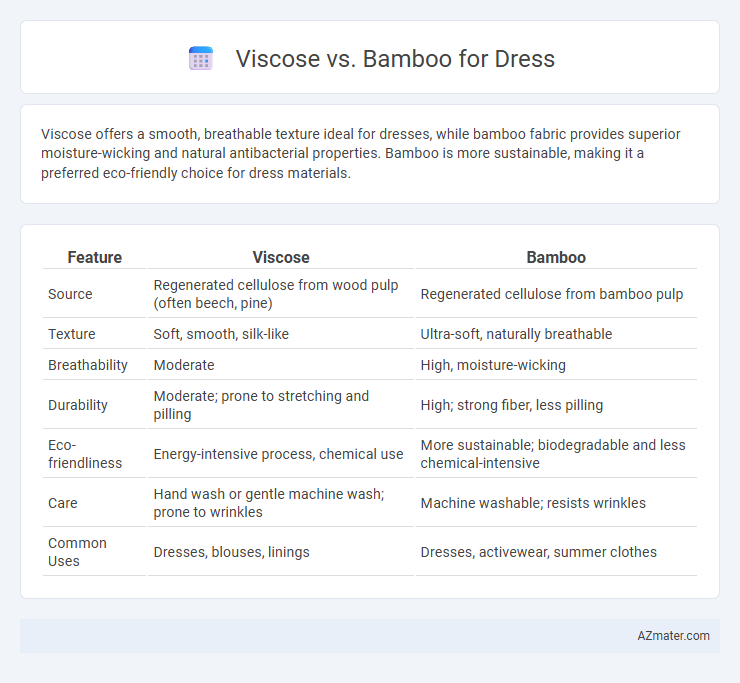Viscose offers a smooth, breathable texture ideal for dresses, while bamboo fabric provides superior moisture-wicking and natural antibacterial properties. Bamboo is more sustainable, making it a preferred eco-friendly choice for dress materials.
Table of Comparison
| Feature | Viscose | Bamboo |
|---|---|---|
| Source | Regenerated cellulose from wood pulp (often beech, pine) | Regenerated cellulose from bamboo pulp |
| Texture | Soft, smooth, silk-like | Ultra-soft, naturally breathable |
| Breathability | Moderate | High, moisture-wicking |
| Durability | Moderate; prone to stretching and pilling | High; strong fiber, less pilling |
| Eco-friendliness | Energy-intensive process, chemical use | More sustainable; biodegradable and less chemical-intensive |
| Care | Hand wash or gentle machine wash; prone to wrinkles | Machine washable; resists wrinkles |
| Common Uses | Dresses, blouses, linings | Dresses, activewear, summer clothes |
Introduction to Viscose and Bamboo Fabrics
Viscose fabric is a semi-synthetic textile derived from cellulose extracted from wood pulp, often featuring a smooth, silky texture ideal for dresses. Bamboo fabric is produced by processing bamboo cellulose, known for its natural antibacterial properties and eco-friendly cultivation compared to traditional cotton. Both materials offer breathable comfort and drape well, making them popular choices for sustainable, stylish dress designs.
Origin and Production Processes
Viscose is a semi-synthetic fiber derived primarily from wood pulp, typically sourced from fast-growing trees like pine, beech, or eucalyptus, undergoing chemical-intensive processing involving sodium hydroxide and carbon disulfide to convert cellulose into a soluble compound. Bamboo fiber, often marketed as eco-friendly, is either mechanically crushed and treated with natural enzymes to produce bamboo linen or chemically processed similar to viscose, making its sustainability dependent on the production method. The distinction in origin lies in raw material--general wood pulp for viscose versus bamboo stalks for bamboo fiber--while both rely on complex chemical treatments for fabric transformation.
Environmental Impact of Viscose vs Bamboo
Viscose production involves chemical-intensive processes that generate significant water pollution and deforestation, contributing to environmental degradation. Bamboo fabric is often marketed as eco-friendly; however, converting bamboo into soft fabric also requires chemical treatments similar to viscose, resulting in comparable environmental impacts. Sustainable alternatives include lyocell or mechanically processed bamboo, which minimize harmful emissions and resource use compared to conventional viscose or chemical-processed bamboo fabrics.
Texture and Comfort Comparison
Viscose offers a smooth, silky texture that drapes elegantly, providing a lightweight and breathable feel ideal for warm climates. Bamboo fabric, known for its natural softness and moisture-wicking properties, delivers superior comfort with a slightly more textured, cushioned touch that enhances airflow and reduces irritation. Both materials excel in comfort, but bamboo stands out for its eco-friendly production and enhanced moisture management, making it a preferred choice for sensitive skin.
Breathability and Moisture Absorption
Viscose and bamboo fabrics both offer excellent breathability, with bamboo slightly outperforming viscose due to its natural micro-gaps that enhance airflow. Bamboo fabric exhibits superior moisture absorption, wicking sweat away from the skin more efficiently, which helps maintain dryness and comfort throughout wear. While viscose provides smoothness and softness, bamboo's natural antibacterial properties further contribute to a fresher garment in warm or humid conditions.
Durability and Longevity
Viscose dresses, derived from wood pulp, offer moderate durability but tend to weaken and lose shape after multiple washes, especially when exposed to water and friction. Bamboo fabric, praised for its natural antibacterial properties, provides superior strength and longer-lasting softness, maintaining integrity through repeated wear and laundering. Choosing bamboo over viscose enhances dress longevity, ensuring better resistance to tearing and degradation over time.
Cost and Affordability
Viscose is generally more affordable than bamboo fabric, making it a popular choice for budget-conscious dressmakers. Bamboo fabric often involves more sustainable processing methods, which can increase its production costs and retail prices. Consumers seeking an eco-friendly option may find bamboo dresses more expensive but with added environmental benefits compared to viscose alternatives.
Fashion Versatility and Style
Viscose and bamboo fabrics both offer exceptional fashion versatility, with viscose known for its smooth texture and vibrant color retention, making it ideal for flowy dresses and elegant styles. Bamboo fabric provides a soft, breathable feel and natural moisture-wicking properties, perfect for casual and eco-conscious fashion choices. Both materials drape well and can be tailored to create chic, comfortable dress designs suitable for various occasions.
Care and Maintenance Tips
Viscose dresses require gentle hand washing or dry cleaning to prevent fabric weakening and maintain their smooth texture, avoiding hot water and harsh detergents that can cause shrinkage or damage. Bamboo dresses benefit from cold water washing and air drying to preserve their natural softness and breathability, with mild soaps recommended to protect the eco-friendly fibers. Both fabrics should be ironed on low heat settings and stored in a cool, dry place to extend the garment's lifespan and retain shape and color vibrancy.
Which is Better for Dresses: Viscose or Bamboo?
Viscose and bamboo fabrics both offer soft, breathable qualities ideal for dresses, but bamboo stands out for its natural antibacterial properties and superior moisture-wicking capabilities, making it better suited for sensitive skin and hot climates. Viscose, derived from wood pulp with chemical processing, tends to have a smoother texture and vibrant dye retention, appealing for elegant or structured dress designs. Bamboo fabric's eco-friendly production and higher durability offer sustainable fashion benefits, positioning it as a preferable choice for environmentally conscious dressmakers seeking comfort and longevity.

Infographic: Viscose vs Bamboo for Dress
 azmater.com
azmater.com